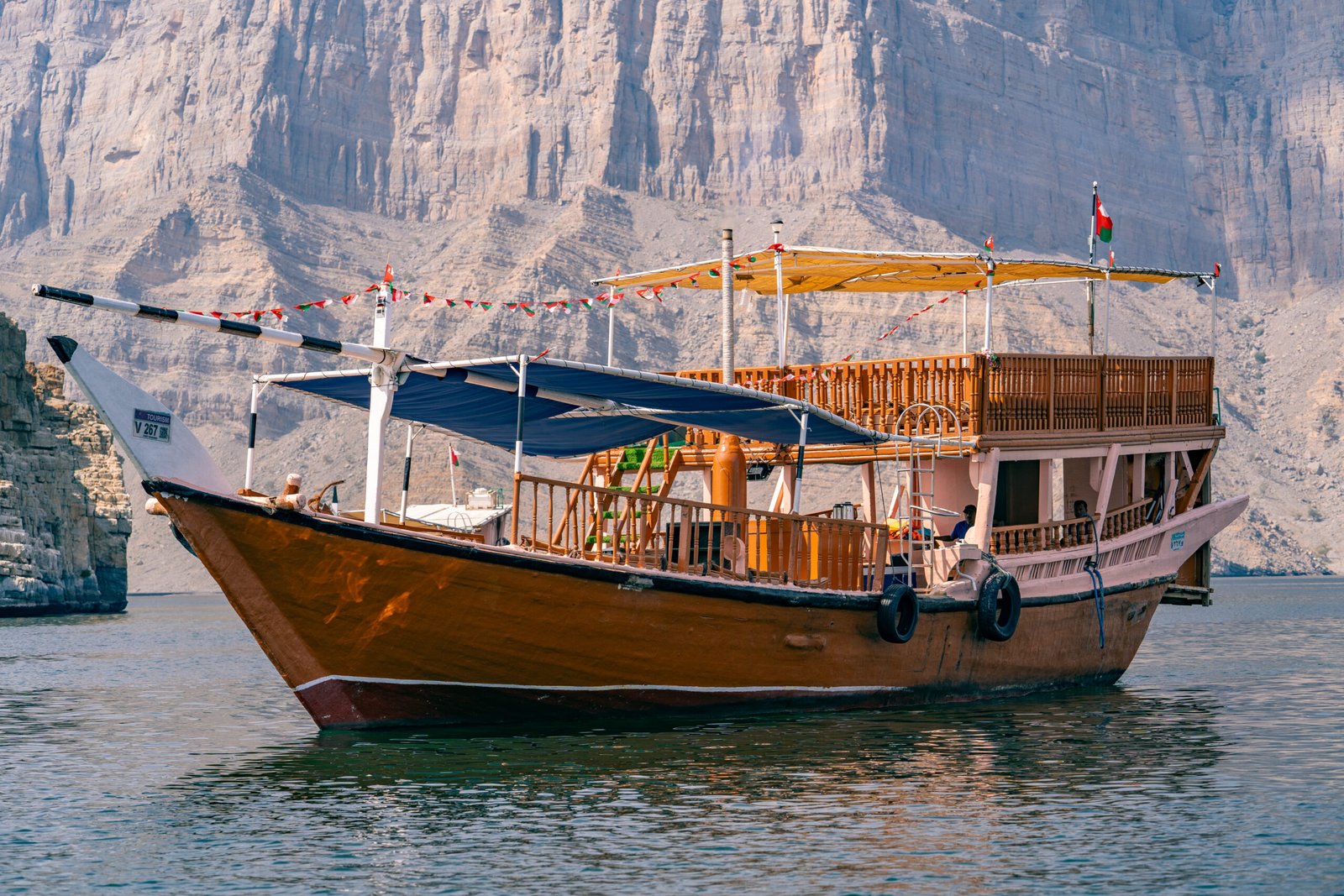
Oman’s traditional dhows are more than just boats; they are enduring symbols of the nation’s rich maritime history. These vessels, crafted with skill and precision, have evolved over centuries, reflecting the resilience of Omani sailors.
Utilizing celestial navigation and understanding wind patterns, Omani mariners mastered the art of sailing, connecting Oman to distant markets and facilitating cultural exchange.
In recent years, there has been a renewed interest in preserving these dhows, emphasizing their cultural significance. Various initiatives aim to promote dhow sailing as both a tourist attraction and a means of celebrating Oman’s maritime heritage.
Understanding this legacy is crucial for appreciating Oman’s identity and its enduring connection to the sea. How do these traditional crafts continue to shape modern Omani society?
What Are Traditional Omani Dhows?
Traditional Omani dhows are wooden sailing vessels that have been integral to Oman’s maritime heritage. Known for their distinctive curved hulls and lateen sails, these boats were primarily used for fishing, pearl diving, and trade across the Arabian Sea.
Historically, Omani dhows, such as the baghlah and sambuk, facilitated commerce with regions in Africa, India, and beyond. Their craftsmanship, utilizing local wood like teak, reflects a deep understanding of the sea and the environment.
Today, these dhows symbolize Oman’s rich cultural identity and are often showcased in festivals and maritime events, attracting both tourists and locals. The revival of traditional boat-building techniques guarantees that the legacy of Omani dhows continues, emphasizing their importance in preserving the nation’s maritime history.
What materials are used to build Omani dhows?
Omani dhows are traditionally constructed using several materials. The primary wood used is teak, known for its durability and resistance to seawater, while coconut fibers and ropes are often employed for rigging and sails.
Additionally, materials like iron and bronze may be used for fittings and tools, ensuring the vessels are robust and seaworthy. These materials are chosen not only for their strength and resilience but also for their historical availability in the region, reflecting centuries of maritime craftsmanship.
How do Omani dhows differ from other boats?
Omani dhows differ from other boats in their traditional design and construction. They feature a distinctive hull shape, often made from teak or mahogany, which provides durability and stability. For those interested in exploring the waters of Oman, consider a Musandam Half Day Dhow Cruise, which offers a modern way to experience the fjords.
Unlike modern boats, dhows utilize lateen sails, allowing for effective sailing against the wind. Their cultural significance in Omani maritime history also sets them apart, as they were historically used for trade and fishing along the Arabian Sea.
What is the History of Omani Dhows?
Omani dhows have a rich history that dates back over a thousand years, playing an essential role in maritime trade in the Arabian Sea and beyond. Originally constructed from wood, these traditional boats were designed for fishing and trading, showcasing the craftsmanship of Omani shipbuilders.
During the 7th to 15th centuries, dhows were instrumental in facilitating trade between Oman and distant regions such as India, East Africa, and Persia. Their unique design, featuring a lateen sail, allowed them to navigate various wind conditions efficiently.
Today, while modern vessels have largely replaced dhows for commercial use, they remain a symbol of Oman’s heritage and are celebrated during cultural festivals, illustrating the enduring legacy of these iconic ships.
How were dhows used in ancient trade routes?
Omani dhows were essential to ancient trade routes, particularly in the Indian Ocean. These wooden vessels, crafted using traditional methods, facilitated commerce between Oman, East Africa, India, and beyond. They transported valuable goods like spices, textiles, and pearls, contributing greatly to Oman’s economic growth and cultural exchanges during the early trade era.
The design of dhows, characterized by their lateen sails and shallow hulls, allowed them to navigate diverse water conditions effectively. Their enduring legacy continues to influence maritime trade practices in the region today. For a deeper understanding of the maritime routes, you might explore the Musandam Tour From Dubai and its significance in Musandam.
What role did dhows play in Oman’s maritime economy?
Omani dhows have historically been essential to Oman’s maritime economy. These traditional wooden boats facilitated trade across the Arabian Sea, linking Oman with regions like East Africa, India, and Persia.
Dhows were used for fishing, pearl diving, and transporting goods such as dates and textiles, greatly contributing to Oman’s economic prosperity.
Today, they symbolize Oman’s rich maritime heritage and continue to attract tourism, showcasing the country’s cultural identity. For those planning a visit, consider checking out the Musandam trip to fully immerse in its cultural and natural beauty.
What Are the Different Types of Omani Dhows?
Omani dhows, traditional sailing vessels, come in several types, each serving distinct purposes. The most common include the dhow, designed for fishing and trade, and the larger, more ornate sambuk used for deep-sea fishing.
Other varieties, like the jalboot, are typically used for transportation, while the baghlah serves as a cargo vessel, showcasing the versatility and cultural significance of these iconic ships in Oman’s maritime history.
Boum: A large sailing dhow for trading
The boum is a large sailing dhow traditionally used for trading in Oman. Known for its robust structure and significant cargo capacity, it is designed to navigate both coastal and open ocean waters.
Boums are essential to Oman’s maritime heritage, facilitating trade across the Arabian Sea and beyond for centuries.
Shu’ai: A small fishing dhow
Shu’ai is a small fishing dhow traditionally used in Oman for coastal fishing. Designed for maneuverability and stability, these vessels typically feature a single mast and a lateen sail, allowing them to navigate the shallow waters of Oman effectively. Their construction usually employs local materials, ensuring they are well-suited for the region’s marine environment.
In addition to fishing, Shu’ai dhows are often used for transporting goods along coastal areas, showcasing their versatility in Omani maritime culture.
Sambuk: A versatile dhow used for fishing and transport
Historically, the Sambuk has played an essential role in local economies, facilitating trade and sustenance for coastal communities.
Its continued use preserves cultural heritage while adapting to modern fishing practices. For a more comprehensive look at fishing in Musandam, you can explore Musandam Diving.
Where Can You Experience Traditional Omani Dhows?
You can experience traditional Omani dhows at various locations, including the bustling Mutrah Corniche in Muscat, where dhows are often docked. Additionally, guided dhow cruises are available along the coast, providing a unique view of Oman’s stunning landscapes.
For a more immersive experience, visit local shipyards in Sur, where craftspeople build and repair these magnificent vessels. Engaging in a dhow sailing trip offers a combination of culture and adventure, allowing you to appreciate Oman’s maritime heritage firsthand.
Dhow cruises in Musandam’s fjords
Dhow cruises in Musandam’s fjords offer a unique experience to explore traditional Omani dhows. These wooden boats, crafted with intricate designs, navigate the stunning fjords, revealing breathtaking landscapes and secluded beaches.
Travelers can enjoy activities like snorkeling and dolphin watching, making it a memorable way to connect with Oman’s maritime heritage. For more on the scenic beauty of Musandam, check out the Musandam fjords.
Maritime museums showcasing dhow heritage
Maritime museums in Oman provide an immersive experience of traditional Omani dhows. Notable locations include the Oman Maritime Museum in Muscat, which showcases the maritime history and craftsmanship of dhows.
Additionally, the National Museum of Oman features exhibits on dhow construction and their significance in Omani culture, highlighting their role in trade and exploration.
Traditional dhow-building yards in Oman
Oman’s traditional dhow-building yards can be found in several notable locations, including Muscat, Sur, and Khasab. These areas are renowned for their craftsmanship and the rich maritime heritage associated with dhow construction. Here, visitors can observe skilled artisans building dhows using ancient techniques, offering a unique insight into Omani culture and history.
In Sur, specifically, the dhow building yard is a prominent attraction where you can witness the entire process from selecting timber to the final touches.
How Are Omani Dhows Used Today?
Omani dhows are still actively used today for fishing, trade, and tourism. These traditional vessels symbolize Oman’s maritime heritage and contribute to the local economy through sustainable practices.
Modern adaptations include luxury dhow cruises that showcase Oman’s stunning coastline, attracting tourists enthusiastic to experience authentic maritime culture.
Tourism and luxury dhow cruises
Omani dhows are now integral to tourism, offering luxury dhow cruises along the stunning coastline of Oman. These cruises provide a unique way to experience the country’s rich maritime heritage, combining traditional boat design with modern amenities for an unforgettable journey on the Arabian Sea.
Tourists can enjoy activities such as swimming, snorkeling, and enjoying sumptuous meals onboard, making these cruises a popular choice for both relaxation and adventure. If you’re planning a family trip, consider why Khasab Musandam Dhow Cruise is ideal for family vacations.
The dhows serve not only as vessels for transportation but also as cultural experiences that showcase Oman’s history and natural beauty.
Fishing and coastal transport
Omani dhows are currently used for fishing and coastal transport, playing an essential role in the local economy. These traditional boats are often utilized by fishermen to catch fish in the Arabian Sea, contributing notably to the fishing industry.
In addition, dhows are also used for transporting goods between coastal cities, facilitating trade and commerce. Their design and functionality have allowed them to remain relevant in today’s maritime activities, merging tradition with modern needs.
Cultural and Heritage Preservation
Omani dhows continue to play a significant role today, primarily in tourism and cultural preservation. These traditional wooden boats are used for sailing tours, offering visitors unique experiences along Oman’s coastline and waterways.
Additionally, dhows are showcased in festivals, preserving their craftsmanship and historical significance, while fostering a sense of national pride.
Conclusion
The traditional craft of building dhows in Oman remains vital, showcasing the rich maritime heritage that connects the Omani people to their ancestors. These boats represent resilience and adaptability, embodying centuries of maritime traditions that have withstood the test of time.
Preserving the dhows is crucial as they symbolize cultural identity and continuity in a world that is changing rapidly. The artisanal skills needed to construct these vessels are passed down through generations, ensuring that this important craft endures for future generations to appreciate and celebrate.
By supporting and valuing the craft of dhow building, we honor Oman’s rich heritage. This commitment fosters a sense of pride within the community and helps maintain cultural significance in a globalized society.
Are you ready to take action and help preserve this important part of Oman’s cultural identity? Engaging with local craftsmen or learning about their techniques can make a meaningful difference in sustaining this cherished tradition.
